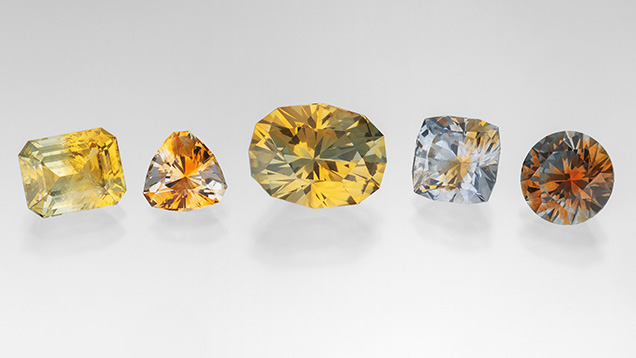Interesting Sapphires from Montana and Australia

While sapphire has always been popular at trade shows, occasionally the authors find some interesting stones with attractive color distribution or growth patterns that have a niche in the market.
At this year’s AGTA show, Potentate Mining carried some spectacular bicolor faceted sapphires and a variety of slabs from its Rock Creek mine in Montana. The Rock Creek operation is one of four active sapphire mines in Montana. Stones from this deposit tend to be flat, showing pastel colors, and many stones show bicolor or have an orange or yellow core called “yolk” by the local miners. Gem cutters and jewelry designers have been finding innovative ways to take advantage of these challenging attributes. Through careful design and cutting, some stones show attractive color combinations such as yellow/green, yellow/light blue, orange/blue, or simply different shades of yellow (figure 1). This type of bicolor is very characteristic of Rock Creek sapphires.

As for the flat rough, Potentate offers several categories based on color, pattern, and weight (figure 2). According to the company’s marketing director, Warren Boyd, both cutters and designers have shown strong interest in these slabs, especially those weighing half a gram and above. Designers seem to prefer slabs with patterns while cutters or carvers prefer slabs with solid colors to make special cuts.

At the GJX show, Terry Coldham from Intogems showed the authors a pair of thin blue sapphire slabs with characteristic hexagonal growth patterns. The pair in figure 3 is from the Inverell sapphire field of New South Wales, Australia. Blue sapphires from this area tend to show a very saturated and dark inky blue color. Slicing them into thin slabs makes the blue color much lighter and more desirable. However, the size and quality of this pair are extremely rare to find. Mr. Coldham also carries many parti-colored and fancy-color Australian sapphires (see figure 4 in the Tucson Overview), which also sold well at the show.
Watch videos of the sapphire slabs from Montana and Australia:



